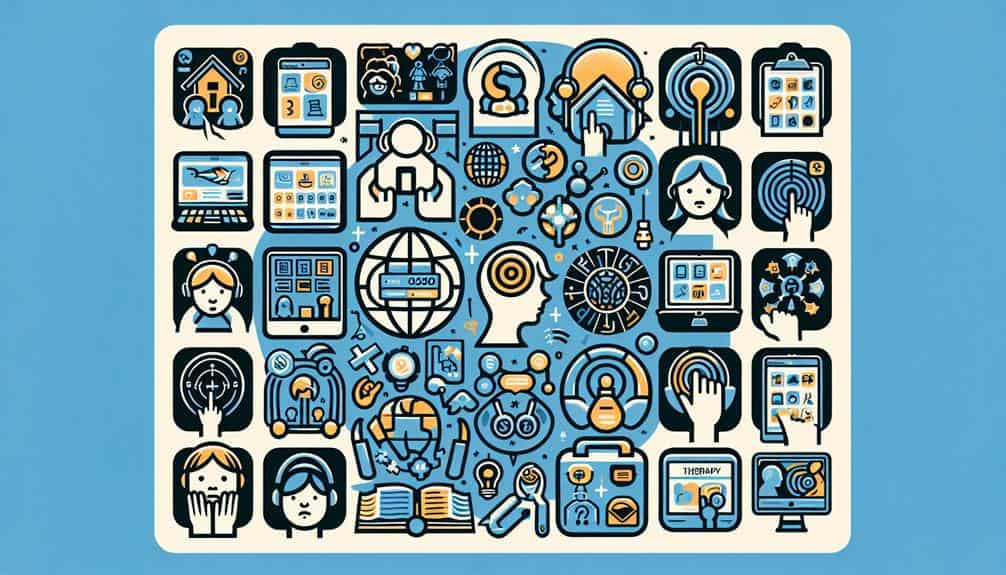Managing homeschooling and therapy for special needs children can be overwhelming. Start by creating a structured schedule balancing schooling and therapy sessions. Integrate therapeutic activities into your routine to nurture growth. Prioritize academic and therapy goals, tailoring plans to meet unique needs. Adjust schedules and techniques as your child progresses. Collaborate with therapists and educators for a holistic approach. Monitor progress closely, offering individualized instruction. By taking a strategic and caring approach, you can provide the support needed for your child's development.
Key Points
- Coordinate therapy and schooling schedules effectively.
- Integrate therapeutic activities into the homeschool routine.
- Set clear goals for academic progress and therapy outcomes.
- Adjust schedules and techniques based on progress.
- Provide individualized instruction and monitor progress closely.
Scheduling Therapy and Schooling
When balancing therapy sessions and homeschooling for your special needs child, it's important to create a well-structured schedule that allows for both learning and therapeutic interventions to complement each other effectively.
Making sure that therapy progress isn't hindered by schooling commitments requires careful planning and coordination. One key aspect to take into account is the flexibility in schooling arrangements. Homeschooling provides a unique opportunity to tailor the educational curriculum around your child's therapy sessions.
By adjusting the daily schedule to accommodate therapy appointments, you can guarantee that your child receives the necessary support while still engaging in meaningful learning activities.
Maintaining a balance between therapy and schooling may require some trial and error to find the best routine that works for your child. It's crucial to communicate openly with therapists and educators to align schedules and goals.
Integrating Therapeutic Activities
To effectively integrate therapeutic activities into your homeschooling routine for your special needs child, consider incorporating them into your daily schedule in a way that complements their learning and development.
Sensory activities play an important role in therapy integration, aiding in regulating emotions and improving focus. You can incorporate sensory breaks throughout the day, such as incorporating playdough or sensory bins during academic lessons. These activities not only provide a therapeutic outlet but also help maintain an academic focus.
When integrating therapeutic activities, it's vital to align them with specific learning outcomes. For instance, if your child is working on fine motor skills, activities like threading beads or tearing paper can be beneficial. By weaving these activities into your homeschooling schedule, you create a holistic approach to addressing your child's needs.
Remember that the aim isn't only therapy but also enhancing their overall learning experience. Through thoughtful integration, you can create a supportive environment that nurtures both their academic and therapeutic requirements.
Prioritizing Academic and Therapy Needs
Consider prioritizing the academic and therapy needs of your special needs child by establishing a balanced routine that addresses both aspects effectively. Time management plays an important role in ensuring that your child receives the necessary academic instruction and therapy sessions.
By setting clear goals for both academic progress and therapeutic outcomes, you can create a structured plan that accommodates both priorities.
Balancing priorities is key when managing homeschooling and therapy for your child. Each child's needs are unique, requiring individualized plans that cater to their specific academic and therapeutic requirements.
It's vital to strike a balance between academic learning and therapeutic interventions, ensuring that both aspects are given adequate attention and importance.
Effective time management and goal setting will help you navigate the challenges of homeschooling and therapy for your special needs child. By prioritizing academic and therapy needs through a well-thought-out routine, you can create a supportive environment that fosters growth and development in both areas.
Setting Realistic Goals and Expectations
Establishing realistic goals and expectations is essential for guiding your special needs child's progress in both academics and therapy. Goal setting plays an important role in providing direction and motivation for your child's learning and development.
When setting goals, consider your child's individual needs and abilities, aiming for objectives that are challenging yet attainable. Effective time management is key to make certain that your child can work towards these goals consistently without feeling overwhelmed.
Communication is crucial in this process. Regularly check in with your child's therapists and educators to discuss progress, challenges, and adjustments that may be needed. Open and honest communication fosters a supportive environment where everyone is working towards the same objectives.
Remember to prioritize self-care as well. Managing homeschooling and therapy for a special needs child can be demanding, so be sure to take breaks, seek support when needed, and practice self-compassion.
Coordinating With Therapists and Educators
Effective coordination with therapists and educators is essential for maximizing the progress and development of your special needs child in both homeschooling and therapy. Collaborating effectively with these professionals can greatly benefit your child's growth.
Start by establishing open lines of communication with therapists and educators. Share your homeschooling goals, strategies, and any concerns you may have. Similarly, be receptive to their insights and recommendations, as they bring valuable expertise to your child's development.
Regularly scheduled meetings or check-ins can help keep everyone on the same page and guarantee that your child's needs are being met holistically. During these interactions, discuss progress, challenges, and any adjustments that may be needed to the homeschooling or therapy plans.
Monitoring Progress and Adjusting Plans
As you navigate the educational and therapeutic journey with your special needs child, tracking therapy milestones, modifying educational strategies, and adapting schedules flexibly will be essential.
By closely monitoring progress and being open to adjusting plans as needed, you can guarantee that your child receives the personalized support they require to thrive.
Tracking Therapy Milestones
Monitoring progress and adjusting therapy plans is vital in guaranteeing the best outcomes for special needs children receiving homeschooling. Tracking therapy milestones involves celebrating achievements, measuring progress, encouraging motivation, and fostering growth. By keeping a close eye on your child's therapy milestones, you can observe the progress they're making and make any necessary adjustments to their treatment plan.
One way to track therapy milestones is by setting specific goals with your therapist and regularly monitoring your child's progress towards those goals. Celebrate each milestone achieved, no matter how small, as it represents a step forward in your child's development. This positive reinforcement can help maintain your child's motivation and keep them engaged in their therapy sessions.
Measuring progress can involve keeping a journal or log of your child's milestones, behaviors, and any changes you notice. This documentation can help you and your therapist evaluate the effectiveness of the current therapy plan and make informed decisions on adjustments needed to further support your child's growth.
Modifying Educational Strategies
To guarantee the best outcomes for your special needs child receiving homeschooling, it's essential to regularly adjust and modify educational strategies based on their progress and needs.
Individualized instruction tailored to your child's specific requirements can enhance their learning experience.
Providing sensory breaks during the day can help them refocus and stay engaged.
Incorporating creative learning approaches can make lessons more enjoyable and effective.
Utilizing adaptive techniques allows for personalized learning that suits your child's unique learning style.
Monitoring progress closely and being open to adjusting plans accordingly ensures that your child is continuously supported in their educational journey.
Remember, flexibility and patience are key as you navigate this process together.
- Individualized instruction: Tailor lessons to meet your child's specific needs.
- Sensory breaks: Offer regular breaks to help your child stay focused.
- Creative learning: Use innovative techniques to make learning fun.
- Adaptive techniques: Adjust teaching methods to match your child's learning style.
- Monitoring progress: Keep track of your child's development and adjust plans as needed.
Adapting Schedules Flexibly
Adjusting your child's schedule flexibly based on their progress and needs is key to ensuring their homeschooling journey remains effective and supportive.
Time management plays an important role in balancing homeschooling and therapy sessions for special needs children. It's important to monitor your child's progress closely and be willing to adjust their schedules as needed.
When balancing homeschooling with therapy sessions, consider setting aside specific blocks of time for each activity. Be open to shifting these blocks around to accommodate unexpected changes or to better suit your child's energy levels. Remember, flexibility is key.
Regularly reviewing and adjusting your child's schedule can help optimize their learning and therapy outcomes. Keep a close eye on how they respond to different activities and adjust accordingly.
Communication with therapists and educators is crucial in ensuring everyone is on the same page and working towards the best interests of your child.
Frequently Asked Questions
How Can I Manage My Child's Anxiety During Therapy and Homeschooling?
To manage your child's anxiety during therapy and homeschooling, practice mindfulness exercises and relaxation techniques. Offer positive reinforcement and use encouragement strategies. Remember, consistency and patience are key in helping your child navigate through these challenges.
Are There Specific Therapy Techniques I Can Incorporate Into Our Homeschooling Routine?
You can enhance your homeschool routine with sensory regulation techniques and movement breaks. These strategies help create a calming and engaging environment for your child. Incorporating these into your day can support their overall well-being and learning experience.
Should I Prioritize Therapy Sessions Over Academic Lessons?
Prioritize therapy balance without neglecting academic progress. Manage time effectively to make sure both are addressed. Remember, emotional well-being is vital. Seek a balance that supports growth in all areas, fostering holistic development for your child.
How Do I Set Achievable Goals for My Child's Progress?
You can set achievable goals for your child's progress by first understanding their current abilities. Progress monitoring helps you track growth and adjust goals as needed. Celebrate small wins and stay flexible to support their development effectively.
How Can I Ensure Effective Communication Between Therapists and Educators?
To guarantee effective communication between therapists and educators, focus on building trust through open dialogue and active listening. Share feedback regularly, highlighting progress and areas for improvement. Collaboration and mutual respect are key for success.



